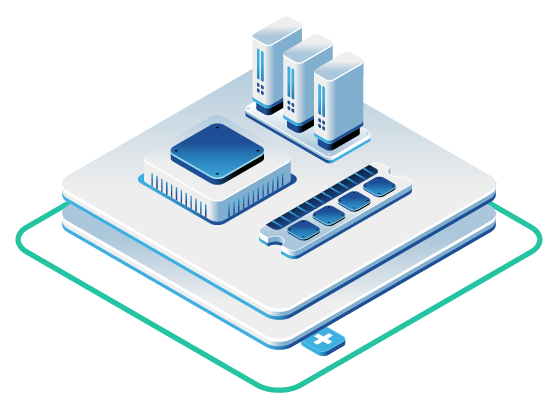In this article
- Key Regulatory Requirements for OpenStack Private Clouds
- OpenStack Security Practices for Compliance
- Setting Up and Auditing Compliance Controls
- OpenMetal’s Role in Compliance-Ready Deployments
- Key Takeaways
- FAQs
- Interested in OpenMetal’s Hosted Private Cloud Powered by OpenStack and Ceph?
Managing compliance in private OpenStack clouds can feel overwhelming, but it doesn’t have to be. Here’s what you need to know to stay secure and meet regulatory standards.
- Why compliance matters: Private OpenStack clouds offer full control over infrastructure, allowing you to align with regulations like HIPAA, PCI DSS, FedRAMP, and SOC 2.
- Key risks during migration: Data breaches cost $4.45M on average. Migration increases exposure, so maintaining compliance throughout the process is critical.
- US compliance frameworks: Regulations like HIPAA (healthcare), PCI DSS (payment security), and FedRAMP (government) demand specific safeguards, such as encryption, access controls, and audit trails.
- OpenStack tools for compliance: Services like Keystone (identity management), Neutron (network security), and Barbican (key management) are essential for meeting regulatory requirements.
- Actionable steps: Use encryption, role-based access, and automated monitoring. Regularly audit configurations, maintain logs, and document your security measures.
Key Regulatory Requirements for OpenStack Private Clouds
When operating private OpenStack clouds in the United States, adhering to specific compliance frameworks is non-negotiable. The most relevant ones include HIPAA, PCI DSS, FedRAMP, and SOC 2.
Major US Compliance Frameworks
FedRAMP is tailored specifically for cloud providers working with federal agencies. It requires strict implementation of NIST 800-53 controls and involves a detailed Authorization to Operate (ATO) process, along with continuous monitoring. Unlike other frameworks, compliance with FedRAMP is mandatory for cloud service providers aiming to secure government contracts.
SOC 2, on the other hand, applies broadly to service organizations, including SaaS and technology companies. SOC 2 rules are getting stricter, pushing private cloud providers and their users to really focus on better data privacy and security. It evaluates five critical areas: security, availability, processing integrity, confidentiality, and privacy. SOC 2 emphasizes the overall maturity of service delivery rather than focusing solely on technical security measures.
HIPAA is essential for protecting sensitive patient information in healthcare environments. Both covered entities and business associates must conduct risk analyses to identify and assess potential threats and vulnerabilities to the confidentiality, integrity, and availability of all ePHI they create, receive, maintain, or transmit. For example, while a covered entity or business associate may use cloud-based services of any configuration (public, hybrid, private, etc.), provided it enters into a Business Associate Agreement (BAA) with the CSP, the type of cloud configuration to be used may affect the risk analysis and risk management plans of all parties. OpenStack deployments managing electronic health records must implement stringent safeguards for Protected Health Information (PHI), such as encryption and strict access controls.
PCI DSS focuses on securing credit card transactions and applies to organizations that process, store, or transmit cardholder data. Key requirements include network segmentation and regular vulnerability assessments, making this framework particularly relevant for OpenStack clouds involved in payment processing.
| Compliance Framework | Scope | Key Requirements | Primary Audience |
|---|---|---|---|
| FedRAMP | U.S. federal cloud security | Continuous monitoring, ATO process | Cloud providers serving federal agencies |
| SOC 2 | Data security for businesses | Evaluation of five trust service criteria | SaaS providers, tech companies, enterprises |
| HIPAA | Healthcare data protection | PHI encryption and access controls | Healthcare providers, insurers, business associates |
| PCI DSS | Payment data security | Network segmentation, vulnerability scans | Retailers, financial institutions, payment processors |
Core Requirements and Documentation
Once you’ve identified the applicable frameworks, the next step is to document and enforce the necessary security controls across your OpenStack deployment. Without proper security hardening, meeting these compliance requirements is nearly impossible.
Security controls are the backbone of compliance documentation. Each core OpenStack service must demonstrate how it handles security functions. Nova; Compute service, Swift; Object storage, Cinder; Block storage, Neutron; DNS service, Keystone; Identity service, Barbican; Key management are among the most critical services for compliance. You’ll need to maintain detailed records showing how each component aligns with regulatory standards.
Audit readiness and reporting are critical as well. This involves maintaining logs, collecting security metrics, conducting regular vulnerability assessments, and documenting remediation efforts. Infrastructure logs: 30 days, Security logs (authentication and API calls): 90 days, Network traffic logs: 60 days, Application metrics (errors and performance): 45 days are typical retention periods for different log types.
Your reporting system should also track configuration changes, access patterns, and security incidents across all OpenStack services. Beyond technical logs, compliance requires documentation of policies, staff training records, and incident response procedures. Each framework specifies what must be documented and how long records must be kept.
Data Privacy and Residency Requirements
Compliance isn’t just about technical measures – it also involves managing where data is stored and how it’s handled. Data privacy and residency are important elements of OpenStack compliance. Private OpenStack clouds give you greater control over data location and processing.
Data residency controls require careful planning to ensure sensitive data is only processed and stored in regions that meet compliance requirements. Maintaining a complete inventory of data across hybrid environments is essential for visibility and control over data flows.
Data disposal and sanitization is another area with strict requirements. OpenStack operators must ensure tenant data is securely erased before media is reused or disposed of. According to NIST guidelines: “The sanitization process removes information from the media such that the information cannot be retrieved or reconstructed. Sanitization techniques, including clearing, purging, cryptographic erase, and destruction, prevent the disclosure of information to unauthorized individuals when such media is reused or released for disposal.”
Privacy-by-default practices should be embedded into your OpenStack deployment from the start. This approach treats all data subjects equally and ensures protective measures are in place from day one. Mapping data flows across your cloud infrastructure is vital for maintaining precise control.
Breach notification requirements vary depending on the framework but generally mandate quick detection and reporting of incidents. Your OpenStack environment should include monitoring tools that provide real-time visibility into cloud operations. These tools can help identify breaches quickly and generate the necessary documentation for regulatory reports.
Using private clouds simplifies compliance for frameworks like HIPAA and GDPR. By avoiding the shared responsibility models of public clouds, private OpenStack deployments allow for a more straightforward approach to meeting regulatory requirements.
OpenStack Security Practices for Compliance
To meet compliance requirements, it’s essential to adopt effective security measures within your OpenStack environment. OpenStack’s security capabilities are often a topic of interest, especially because open source software is sometimes mistakenly viewed as less secure than closed source/proprietary software. But, when configured and maintained properly, OpenStack’s private cloud infrastructure can match or exceed the security of major proprietary solutions.
Authentication and Access Controls
Keystone, OpenStack’s identity service, plays a central role in managing authentication and access. By implementing role-based access control (RBAC), you can limit access to resources based on specific user roles and responsibilities.
RBAC organizes permissions based on job roles rather than assigning them individually. This simplifies access management and strengthens security in OpenStack setups. Different roles provide different access levels – Cloud Admin gets full system access for managing infrastructure, Project Admin has project-wide control for overseeing department projects, and Auditor receives read-only access for monitoring compliance.
Strengthen security by enabling multi-factor authentication (MFA) and enforcing strong password policies for all accounts. Following the principle of least privilege ensures that users and services only have access to what they need to perform their tasks. The philosophy around the principle of least privilege is a user account should only have privileges necessary to perform its intended function. Regularly review and audit access permissions to identify and remove unnecessary privileges.
Track user activity by logging authentication events, role assignments, and any changes in privileges. For centralized and consistent authentication, consider integrating Keystone with external identity providers like Active Directory, LDAP, or SAML.
Data Encryption and Secure Communication
Once access controls are in place, encryption becomes crucial for protecting data both in transit and at rest. Encryption in private clouds covers two main areas: data at rest (stored data) and data in transit (data being transferred). OpenStack supports both types of encryption through its various services.
To secure communications, use TLS 1.2 or higher and disable outdated protocols such as SSL and older TLS versions. Proper key management is critical – using solutions like Hardware Security Modules (HSMs) can add an extra layer of protection, especially for compliance with stringent data security standards. OpenStack’s Barbican service can help centralize key management and integrate seamlessly with HSMs.
Managing encryption keys effectively is just as important as encryption itself. OpenStack’s Barbican service offers centralized management for encryption keys and other sensitive information. Best practices include using Hardware Security Modules (HSMs), rotating keys regularly (monthly for high-risk data and quarterly for lower-risk assets), and auditing key access with detailed audit trails.
Strengthen your network security by employing network segmentation and firewall configurations. Software-defined networking (SDN) can help isolate traffic, while distributed firewalls and intrusion detection/prevention systems can monitor and control access. Ensure that sensitive data is encrypted at rest, whether stored in block storage (Cinder), object storage (Swift), or databases, and in transit, including API communications and inter-service exchanges.
Monitoring and Vulnerability Management
Continuous monitoring is essential for identifying and addressing potential threats. Organizations should always have security monitoring for detecting threats as a top priority. Centralized logging across different OpenStack layers helps identify threats more effectively.
Deploy a logging and monitoring solution to capture security events from all core OpenStack services, enabling timely detection of threats. Real-time monitoring significantly reduces the time it takes to detect breaches. Extend visibility by monitoring key areas, such as: Failed authentication attempts: Look for unusual login failure patterns. API usage anomalies: Keep an eye on unexpected spikes in API activity. Resource consumption anomalies: Detect irregular infrastructure usage. Security group policy deviations: Identify any unauthorized changes.
Conduct regular vulnerability assessments to uncover weaknesses, such as misconfigurations, unpatched software, or potential exploits. Address these risks with strategies like access control lists (ACLs) and ongoing monitoring.
Automation tools like Ansible or Puppet can help maintain consistent security configurations while minimizing human error. Regular security audits and log reviews ensure your defenses remain effective over time.
Staying up to date with patch management is equally important. Regularly update OpenStack components and underlying software to protect against known vulnerabilities. Keep an eye on official OpenStack advisories and updates from the OpenStack Vulnerability Management Team for the latest security guidance.
Lastly, prepare for incidents by developing a detailed response plan. This plan should outline steps for containment, investigation, notification, and recovery in case of a breach. Regularly test and refine these procedures to meet compliance requirements and ensure a swift, effective response when needed.
Setting Up and Auditing Compliance Controls
To consistently meet regulatory requirements, it’s essential to establish systematic compliance controls. This involves creating clear mappings between compliance frameworks and your technical implementations, followed by ongoing validation through automated evidence collection and regular assessments.
Mapping Controls to Regulatory Requirements
Start by creating a matrix that links OpenStack components to specific compliance requirements. This approach connects regulatory frameworks like SOC 2, ISO 27001, or HIPAA with the technical controls implemented through OpenStack services.
Identify how each OpenStack component addresses compliance needs. For example, Keystone’s role-based access control supports access management requirements across multiple frameworks. Similarly, Neutron’s network segmentation meets network isolation mandates, Barbican’s key management addresses encryption key storage, and Swift and Cinder’s encryption capabilities align with data protection controls.
Document the specific ways OpenStack services contribute to compliance. Go beyond general statements like “encryption is enabled.” Instead, include details such as the encryption algorithms in use, key rotation schedules, and access control configurations. This level of detail is invaluable during audits and helps maintain consistency across your systems.
Keep the control matrix updated as your OpenStack deployment evolves. If you add new services or modify configurations, update the corresponding compliance mappings immediately. This ensures your organization is always audit-ready.
Automating Evidence Collection for Audits
Manually collecting evidence for audits can be tedious and error-prone. Automation not only eliminates these challenges but also significantly reduces preparation time.
OpenStack’s logging capabilities are a great starting point for automation. Configure centralized logging to capture key events, such as authentication attempts, configuration changes, and access patterns. Tools like Ceilometer can automatically collect time-stamped evidence of system activities, creating a detailed audit trail of compliance-related events.
According to a February 2024 survey by Secureframe, 79% of users identified automated evidence collection as a top feature, while 57% pointed to the lack of centralized compliance data storage as a major challenge.
Enable real-time monitoring to alert you to any deviations from compliance controls. This proactive approach helps prevent gaps and ensures continuous adherence to regulations. Automation can cut audit preparation time by 70% or more, freeing your team to focus on strategic initiatives instead of manual documentation.
Running Compliance Assessments
While automation simplifies many aspects of compliance, regular assessments remain crucial. These should include both automated testing and manual reviews to provide a thorough understanding of your compliance posture.
Conduct internal assessments quarterly to identify issues like configuration drift, gaps in access control, or lapses in monitoring. Pay special attention to high-risk areas, such as command and control functions and base virtualization technologies.
Compliance means adhering to regulations, specifications, standards, and laws. It is also used when describing an organization’s status regarding assessments, audits, and certifications. Compliance, when done correctly, unifies and strengthens the other security topics discussed in this guide.
Schedule external audits annually or as dictated by your regulatory frameworks. To prepare, ensure your automated systems have collected sufficient documentation throughout the year. For example, a SOC 2 audit can take up to 9 months to prepare and 3 months to complete, making continuous readiness a necessity.
Include vulnerability assessments as part of your regular compliance checks. Misconfigurations are a major concern, accounting for 23% of all security-related incidents. Review OpenStack service configurations against established baselines, document any deviations, and create remediation plans with clear timelines.
Develop detailed workflows to address any compliance gaps identified during assessments. These workflows should specify who is responsible, set deadlines, and outline validation procedures. Use your automated monitoring systems to track progress and ensure that issues are resolved fully and don’t recur.
Finally, maintain thorough documentation of all assessment activities, findings, and remediation efforts. This documentation not only serves as evidence of ongoing compliance but also provides insights to strengthen your overall security practices.
OpenMetal’s Role in Compliance-Ready Deployments
Navigating compliance in OpenStack deployments can be a challenge, but OpenMetal’s private cloud infrastructure makes it significantly more manageable. By offering dedicated hardware, predictable pricing, and integrated security features, OpenMetal helps reduce the complexities often associated with traditional multi-tenant cloud solutions.
Features Supporting Compliance
OpenMetal’s single-tenant hardware is designed to meet regulations that require strict data isolation. With full control over data location and root access to your infrastructure, you can configure security settings and maintain audit trails that align with compliance standards.
| Feature | Compliance Benefit |
|---|---|
| Dedicated Hardware | Guarantees physical separation and stronger security with single-tenant infrastructure |
| Customizable Security | Allows tailored security measures through configurable platform policies |
| Resource Monitoring | Offers real-time visibility into compliance via OpenStack monitoring tools |
| Access Control | Ensures precise user management with role-based access control systems |
OpenMetal’s fixed pricing model not only simplifies budgeting but also ensures continuous funding for critical security tools. Additionally, organizations can save 30% to 60% on cloud costs compared to traditional public cloud solutions, freeing up resources for compliance assessments and tools.
These features create a solid foundation for rapid deployment and comprehensive audit readiness.
Quick Deployment and Scalability
Rapid deployment is essential to minimizing compliance risks during cloud migration. OpenMetal’s Hosted Private Clouds can be operational in as little as 45 seconds, significantly reducing the time between planning and execution.
“OpenMetal Cloud provides on-demand private infrastructure, which brings cloud fundamentals like elasticity and usage billing to the cloud deployment itself. It’s awesome to see OpenMetal’s latest product use OpenStack to combine the benefits of public cloud and managed private cloud, powered by open infrastructure.” – Thierry Carrez, VP of Engineering, Open Infrastructure Foundation
Scalability is another key factor in maintaining compliance as your organization grows. OpenMetal delivers up to 3.5x greater efficiency compared to public cloud alternatives. This means you can expand your infrastructure without adding unnecessary complexity or management burdens.
The combination of fast deployment and scalable infrastructure ensures that your compliance measures remain intact, even as your needs evolve.
Audit Support and US Regulations
OpenMetal’s platform is built to address the audit challenges posed by major US compliance frameworks. With full access to system and hardware logs, the architecture ensures complete transparency and traceability.
For SOC 2, the platform simplifies evidence collection through detailed logging and monitoring. Its consistent bare metal performance eliminates “noisy neighbor” issues, a common problem in shared environments that can hinder compliance efforts.
When it comes to HIPAA, OpenMetal provides both physical and logical network isolation. Healthcare organizations can confidently implement safeguards, knowing that sensitive health data remains securely separated from other tenants. Dedicated hardware ensures protected health information stays within controlled boundaries throughout its entire lifecycle.
OpenMetal’s Tier III data centers, located in North America, Europe, and Asia, provide flexibility for meeting geographic data residency requirements. This allows organizations to choose specific locations to comply with state-level regulations or industry-specific geographic restrictions.
For businesses juggling multiple compliance requirements, OpenMetal’s adaptability is refreshing. In 2023, nearly 70% of service organizations needed to meet at least six different compliance frameworks. With customizable security policies and a flexible software stack, OpenMetal allows organizations to address diverse regulatory needs within a single infrastructure setup.
Key Takeaways
Navigating compliance in private OpenStack clouds requires a thoughtful approach that balances security, operational efficiency, and regulatory demands. Companies that embed compliance into their strategy from the outset often reap substantial rewards, with 70% of business leaders acknowledging the effectiveness of compliance measures.
The financial impact of data breaches is staggering, with incidents like Capital One’s 2019 breach serving as a stark reminder of the risks posed by insufficient security measures. Strong compliance practices are not just a regulatory requirement – they are a financial safeguard.
To enhance your compliance efforts, consider integrating these key technical controls into your migration strategy:
- Use Keystone for managing access control, Neutron for network segmentation, and Barbican for encryption to meet audit requirements.
- Incorporate automated testing tools to continuously monitor compliance.
- Keep thorough documentation from internal audits to streamline external assessments.
- Train your team to quickly identify and address security vulnerabilities.
According to the OpenInfra Foundation, OpenStack deployments are expected to quadruple by 2029 — a testament to the platform’s maturity and reliability. Organizations that establish strong compliance practices today will be better equipped to handle this transition and position themselves for long-term success.
For businesses managing diverse compliance obligations – whether it’s HIPAA, SOC 2, FedRAMP, or others – OpenStack’s adaptability makes a huge difference. The key lies in implementing controls that meet current regulations while staying flexible enough to evolve with changing requirements. By focusing on these principles, you’ll be well-prepared for a secure and compliant OpenStack migration.
FAQs
What are the advantages of using OpenStack to ensure compliance in private cloud environments?
OpenStack provides a strong foundation for meeting compliance needs in private cloud environments. It delivers improved security measures, better control, and the freedom to adapt your setup. Thanks to its modular design, you can customize your cloud infrastructure to align with specific regulatory standards while keeping operations running smoothly.
Using OpenStack, you can put in place stringent access controls, encrypt sensitive data, and enable thorough auditing to safeguard information and comply with regulations. Moreover, its open source framework promotes transparency and adaptability, helping you navigate changing compliance demands with greater ease.
How can OpenStack tools like Keystone, Neutron, and Barbican help meet compliance standards such as HIPAA or PCI DSS?
OpenStack includes a suite of tools – Keystone, Neutron, and Barbican – that are essential for meeting security and data protection requirements outlined in standards like HIPAA and PCI DSS.
- Keystone manages identity and access securely by authenticating users and enforcing access controls. This ensures that only authorized individuals can access sensitive data.
- Neutron strengthens network security by offering features such as network segmentation and security groups. These tools help isolate and protect data flows, aligning with strict compliance requirements.
- Barbican delivers encryption services for both data at rest and in transit, shielding sensitive information from unauthorized access.
Using these tools, you can create a private cloud environment with OpenStack that prioritizes both security and compliance.
How can I automate compliance evidence collection and monitoring in an OpenStack private cloud?
To make managing compliance in your OpenStack private cloud more efficient, focus on automating how you collect and monitor evidence. Use specialized tools that can automatically gather compliance artifacts and validate them, cutting down on manual work and reducing the risk of mistakes. By implementing continuous monitoring, you can stay ahead of potential compliance issues and address them quickly. Automation scripts can further simplify the process of collecting and validating data. These approaches not only save you time but also help establish a more dependable compliance system for your private cloud setup.
Schedule a Consultation
Get a deeper assessment and discuss your unique requirements.
Read More on the OpenMetal Blog


































